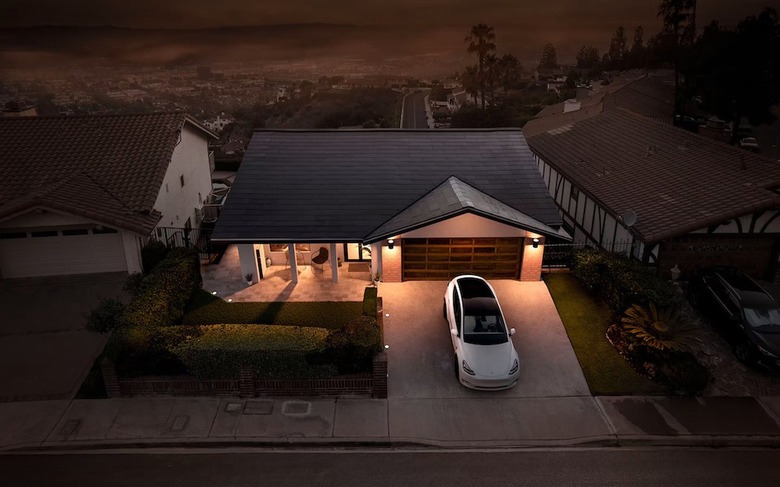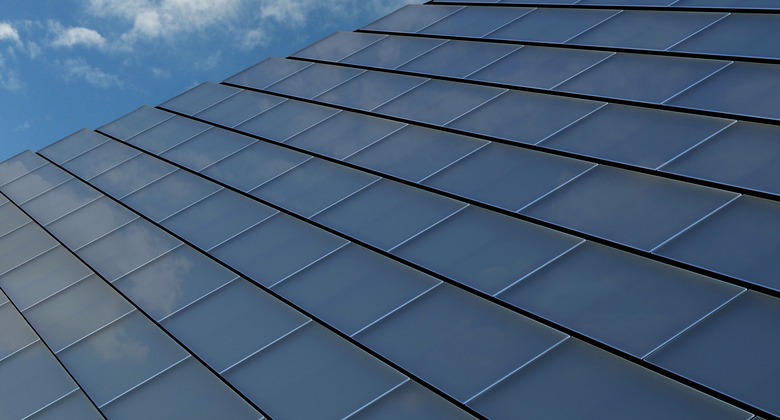Solar Shingles 101: A Homeowner's Guide
Homeowners who are considering taking advantage of solar energy to do their part for the environment, give back to the community, and save on their electrical bill should definitely consider solar shingles, but they should also manage their expectations. In theory, replacing your existing roofing with an array of tiny solar generators seems like a no-brainer, but it's important to remember that photovoltaic (PV) shingles represent a technology that's still very much in the developmental phase. After all, they have only been available in any form since 2005.
You may be disappointed, for example, if you expect your solar-shingled roof to look like a conventional one. Sure, if money is no object, you can install the Tesla solar roof, which is the gold standard in today's market and does resemble a shingled roof, but to do that, you'll have to rebuild your entire roof, and the cost can be prohibitively high. Many less expensive alternatives that can be integrated with conventional roofing materials look less like roofing and more like conventional solar panels that sit flush with the roof decking.
Moreover, you might be disappointed if your roof isn't a good candidate for solar shingles. Unlike solar panels, shingles can't be adjusted to face the sun, so unless a significant portion of your roof already faces the sun, your expensive solar shingles will underperform. To get a clear idea of whether solar shingles are a good investment for you, you need to know what they are and how they differ from traditional solar panels.
What Are Solar Shingles?
What Are Solar Shingles?
Solar shingles and solar tiles — a related product — are basically mini photovoltaic panels. The average size is about 12 inches wide by 86 inches long — similar in width to an asphalt shingle — and a typical array adds about 13 pounds per square foot of weight to the roof. Each shingle or tile generates from 13 to 63 watts depending on the type, so a full array of 350 units covering an entire roof could potentially generate from 4.5 to 22 kW (kilowatts) of electricity, which is more than enough to power most single-family homes with extra to spare and sell back to the power company (where this option is available). Even a partial array of 100 high-efficiency shingles occupying about 700 square feet on the south-facing part of the roof could generate 6 kW.
Solar shingles can be as flexible as asphalt shingles or rigid like solar panels depending on how they are made. The semiconducting material in the most flexible ones is a combination of copper, indium, gallium, and selenide known as CIGS, while the more rigid ones have solar cells made from monocrystalline or polycrystalline silicon, the same semiconductor used in computer chips. CIGS shingles convert 10 to 12 percent of incident sunlight to electricity, while more efficient silicon shingles have a conversion efficiency of 15 to 20 percent.
Not every solar roof is completely covered with photovoltaic shingles — that's something of an idealization even though it's possible with Tesla or Luma systems. It's usually more economical to install solar roof tiles or shingles on a portion of the roof and integrate them with conventional roofing. The Apollo II roofing system from CertainTeed and Suntegra's solar shingles are two examples of systems designed for this application. Power output is less than it would be if you took advantage of your entire roof area, but it can still be enough to meet your energy needs and eliminate your electric bill.
What's Involved With Installation?
What's Involved With Installation?
Installation of a solar roof system is not a DIY project. The contractor you hire must be experienced in solar shingle installation and preferably have certification from the North American Board of Certified Energy Practitioners. Because a solar power installation calls for electrical hookups, some states require an electrician's license, and other states, such as California, require a solar contracting license. The choice of installer is crucial and you should check references and customer review scores carefully before committing to work with one.
Unlike solar panels, which can be mounted on top of existing roofing, solar shingles and tiles are most economical when installed as part of a new roofing system. Tesla offers the most comprehensive plan and will design and build an entire new roof as part of the installation, which is one reason the company's solar roof is the most expensive on the market. For the design-conscious homeowner, however, even the top-end estimate of $100,000 might not be out of the question because the Tesla roof, like the Tesla electric vehicle, is the most elegant product of its kind on the market, although its availability remains somewhat elusive.
Other products, such as the Apollo II system, don't necessarily call for modifications of the roof structure, but they have to be installed on bare decking, and that requires removal of the existing roof covering. Although the shingles are designed to act as a roof covering, they have electrical wiring that has to be incorporated into the installation, and they have frames with special flashing designed to tie into conventional roofing materials. The wiring feeds through the roof to an inverter, which converts the DC current generated by the panels to AC current used by the household electrical system. A Tesla installation includes a Powerwall, which combines an inverter with battery storage.
Reasons to Install Solar Shingles
Reasons to Install Solar Shingles
If you're ready to power your house with renewable energy from the sun, you have the choice of installing solar panels or solar shingles/tiles. Any sizable solar installation qualifies you for tax incentives, such as the 26 percent solar tax credit (provided you act before the end of 2022 when it reduces to 22 percent) as well as other rebates from local governments. Solar shingles offer these advantages over solar panels:
- Low profile: Rather than sticking up imposingly over the roof, solar shingles are part of the roof covering and are unobtrusive if not invisible.
- Weather-resistant: Unlike solar panels, which act like sails in high winds and can be torn away from their mountings, solar shingles can withstand hurricane-force winds as well as hail (traditional panels are also resistant to hail damage).
- Dual function: Besides generating electricity, solar shingles also provide a roof covering. If your existing roof is old and you need a roof replacement, you can catch two birds in one bucket by opting for shingles over panels.
- Low maintenance: Solar shingles can last 25 to 30 years with minimal maintenance. Tesla previously specified its warranty period as "infinity" but has since downgraded that to 25 years. Other products carry similar warranties.
There's Always a Downside
There's Always a Downside
Solar shingles are most cost-effective when installed on simple roofs with plenty of sun exposure. Installation costs go up and energy output goes down on complex roofs with overhangs, dormers, and other features that shade other parts of the roof. Besides this, solar shingles may not be able to function as a roof covering on roofs with low slopes. The Apollo II system, for example, is designed for roof pitches of 4:12 or greater. Moreover, the shingles or tiles can't be cut or altered in any way, so if a plumbing or exhaust vent intersects the part of the roof on which you want to install them, you'll have to relocate the pipe or vent, which adds to the cost of solar shingles installation.
Solar cell efficiency is another thing to keep in mind. Even the highest-quality solar shingles are currently less efficient than solar panels, but that may not be true for long, considering that solar shingles represent a young industry that is still being developed. Tesla now uses quartz instead of silicon in the manufacture of its shingles, and the company hopes that will boost efficiency beyond the typical 15 to 18 percent for solar tiles, although data confirming enhanced efficiency isn't yet available. By contrast, solar panels are typically 22 to 23 percent efficient.
Managing Installation Costs
Managing Installation Costs
Because a DIY installation isn't an option, the installation costs of a solar shingle system includes the cost of labor as well as the costs of the shingles, inverter, wires, and mounting equipment, and they depend not only on the brand of the system you choose but also the contractor. Tesla estimates the cost of installation for its products to be around $22 per square foot, which, as you have probably guessed, is on the extreme high end. A full-scale installation of a Tesla solar roof costs anywhere from $70,000 to over $100,000 depending on roof size and complexity.
Installation of products from other manufacturers, such as Suntegra, Luma, CertainTeed, or RGS Energy (formerly Dow) costs an average of $15,000 to $20,000. This doesn't include any tax incentives or rebates, which are subtracted from the total cost. It's difficult to fix a universally applicable cost range, however, given that so many variables are involved, including:
- Roof complexity
- Product cost
- Total area of the array
- Local labor costs
The best time to install solar shingles is when you need a new roof, so if you're committed to doing that anyway, you can deduct some of the cost of a conventional roof installation from the cost of adding solar. Since a roof replacement costs $5,000 to $10,000 on average, the cost offset provided by the solar area can be significant, and the total cost becomes even more reasonable after you deduct the tax credits and incentives.
References
- YouTube: CertainTeed Roofing – Installation Instructions for CertainTeed's Apollo II Solar Roofing System
- Solar Magazine: Solar Shingles: Make Your Roof Solar-Powered (5 Brands)
- Solar Power Authority: Solar Shingles 101: Pros, Cons & Best Brands
- Solar Energy International: State Licensing Requirements
- Energy Sage: Tesla Solar Roof: The Complete Review
- SolarReviews: Types of Solar Panels: Which One Is the Best Choice?

